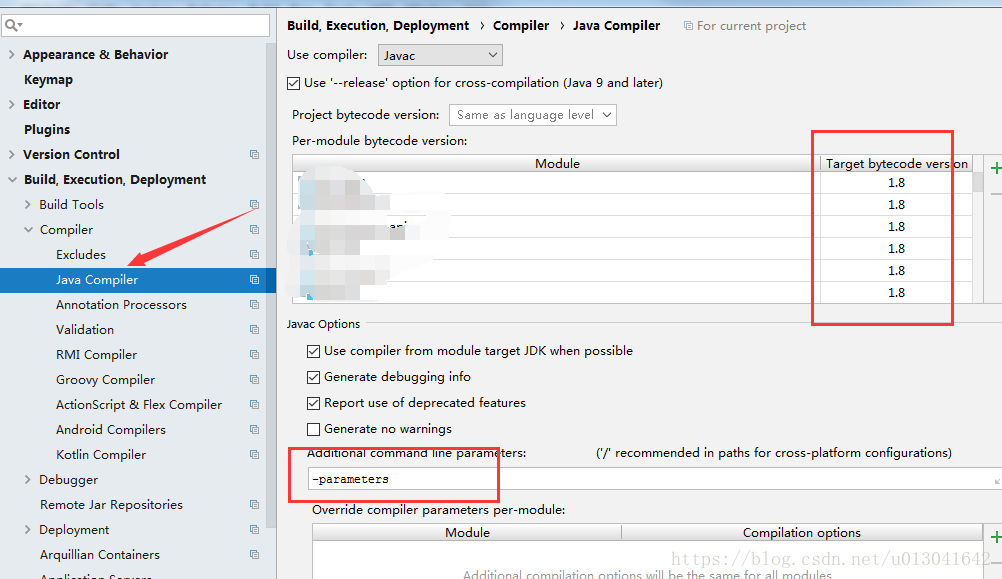жӮЁеҘҪпјҢзҷ»еҪ•еҗҺжүҚиғҪдёӢи®ўеҚ•е“ҰпјҒ
жӮЁеҘҪпјҢзҷ»еҪ•еҗҺжүҚиғҪдёӢи®ўеҚ•е“ҰпјҒ
иҝҷзҜҮж–Үз« дё»иҰҒи®Іи§ЈдәҶвҖңSpringAOP йҖҡиҝҮJoinPointиҺ·еҸ–еҸӮж•°еҗҚе’ҢеҖјзҡ„ж–№жі•вҖқпјҢж–Үдёӯзҡ„и®Іи§ЈеҶ…е®№з®ҖеҚ•жё…жҷ°пјҢжҳ“дәҺеӯҰд№ дёҺзҗҶи§ЈпјҢдёӢйқўиҜ·еӨ§е®¶и·ҹзқҖе°Ҹзј–зҡ„жҖқи·Ҝж…ўж…ўж·ұе…ҘпјҢдёҖиө·жқҘз ”з©¶е’ҢеӯҰд№ вҖңSpringAOP йҖҡиҝҮJoinPointиҺ·еҸ–еҸӮж•°еҗҚе’ҢеҖјзҡ„ж–№жі•вҖқеҗ§пјҒ
еңЁJava8д№ӢеүҚпјҢд»Јз Ғзј–иҜ‘дёәclassж–Ү件еҗҺпјҢж–№жі•еҸӮж•°зҡ„зұ»еһӢеӣәе®ҡпјҢдҪҶжҳҜж–№жі•еҗҚз§°дјҡдёўеӨұпјҢж–№жі•еҗҚз§°дјҡеҸҳжҲҗarg0гҖҒarg1вҖҰ.гҖӮеңЁJava8ејҖе§ӢеҸҜд»ҘеңЁclassж–Ү件дёӯдҝқз•ҷеҸӮж•°еҗҚгҖӮ
public void tet(JoinPoint joinPoint) {
// дёӢйқўдёӨдёӘж•°з»„дёӯпјҢеҸӮж•°еҖје’ҢеҸӮж•°еҗҚзҡ„дёӘж•°е’ҢдҪҚзҪ®жҳҜдёҖдёҖеҜ№еә”зҡ„гҖӮ
Object[] args = joinPoint.getArgs(); // еҸӮж•°еҖј
String[] argNames = ((MethodSignature)joinPoint.getSignature()).getParameterNames(); // еҸӮж•°еҗҚ
}жіЁж„Ҹпјҡ
IDEA еҸӘжңүи®ҫзҪ®дәҶ Java зј–иҜ‘еҸӮж•°жүҚиғҪиҺ·еҸ–еҲ°еҸӮж•°дҝЎжҒҜгҖӮ并且jdkиҰҒеңЁ1.8еҸҠд»ҘдёҠзүҲжң¬гҖӮ

еўһеҠ compilerArgs еҸӮж•°
<plugins>
<plugin>
<groupId>org.apache.maven.plugins</groupId>
<artifactId>maven-compiler-plugin</artifactId>
<version>${maven_compiler_plugin_version}</version>
<configuration>
<source>${java_source_version}</source>
<target>${java_target_version}</target>
<encoding>${file_encoding}</encoding>
<compilerArgs>
<arg>-parameters</arg>
</compilerArgs>
</configuration>
</plugin>
</plugins>Preferences->java->CompilerдёӢеӢҫйҖүStore information about method parametersйҖүйЎ№гҖӮ
иҝҷж ·еңЁдҪҝз”Ёeclipseзј–иҜ‘javaж–Ү件зҡ„ж—¶еҖҷе°ұдјҡе°ҶеҸӮж•°еҗҚз§°зј–иҜ‘еҲ°classж–Ү件дёӯгҖӮ
JoinPointеҜ№иұЎе°ҒиЈ…дәҶSpringAopдёӯеҲҮйқўж–№жі•зҡ„дҝЎжҒҜ,еңЁеҲҮйқўж–№жі•дёӯж·»еҠ JoinPointеҸӮж•°,е°ұеҸҜд»ҘиҺ·еҸ–еҲ°е°ҒиЈ…дәҶиҜҘж–№жі•дҝЎжҒҜзҡ„JoinPointеҜ№иұЎ.
еёёз”ЁAPI
| ж–№жі•еҗҚ | еҠҹиғҪ |
|---|---|
| Signature getSignature(); | иҺ·еҸ–е°ҒиЈ…дәҶзҪІеҗҚдҝЎжҒҜзҡ„еҜ№иұЎ,еңЁиҜҘеҜ№иұЎдёӯеҸҜд»ҘиҺ·еҸ–еҲ°зӣ®ж Үж–№жі•еҗҚ,жүҖеұһзұ»зҡ„ClassзӯүдҝЎжҒҜ |
| Object[] getArgs(); | иҺ·еҸ–дј е…Ҙзӣ®ж Үж–№жі•зҡ„еҸӮж•°еҜ№иұЎ |
| Object getTarget(); | иҺ·еҸ–иў«д»ЈзҗҶзҡ„еҜ№иұЎ |
| Object getThis(); | иҺ·еҸ–д»ЈзҗҶеҜ№иұЎ |
ProceedingJoinPointеҜ№иұЎжҳҜJoinPointзҡ„еӯҗжҺҘеҸЈ,иҜҘеҜ№иұЎеҸӘз”ЁеңЁ@Aroundзҡ„еҲҮйқўж–№жі•дёӯ,
ж·»еҠ дәҶд»ҘдёӢдёӨдёӘж–№жі•гҖӮ
Object proceed() throws Throwable //жү§иЎҢзӣ®ж Үж–№жі• Object proceed(Object[] var1) throws Throwable //дј е…Ҙзҡ„ж–°зҡ„еҸӮж•°еҺ»жү§иЎҢзӣ®ж Үж–№жі•
еҲҮйқўзұ»
@Aspect
@Component
public class aopAspect {
/**
* е®ҡд№үдёҖдёӘеҲҮе…ҘзӮ№иЎЁиҫҫејҸ,з”ЁжқҘзЎ®е®ҡе“Әдәӣзұ»йңҖиҰҒд»ЈзҗҶ
* execution(* aopdemo.*.*(..))д»ЈиЎЁaopdemoеҢ…дёӢжүҖжңүзұ»зҡ„жүҖжңүж–№жі•йғҪдјҡиў«д»ЈзҗҶ
*/
@Pointcut("execution(* aopdemo.*.*(..))")
public void declareJoinPointerExpression() {}
/**
* еүҚзҪ®ж–№жі•,еңЁзӣ®ж Үж–№жі•жү§иЎҢеүҚжү§иЎҢ
* @param joinPoint е°ҒиЈ…дәҶд»ЈзҗҶж–№жі•дҝЎжҒҜзҡ„еҜ№иұЎ,иӢҘз”ЁдёҚеҲ°еҲҷеҸҜд»ҘеҝҪз•ҘдёҚеҶҷ
*/
@Before("declareJoinPointerExpression()")
public void beforeMethod(JoinPoint joinPoint){
System.out.println("зӣ®ж Үж–№жі•еҗҚдёә:" + joinPoint.getSignature().getName());
System.out.println("зӣ®ж Үж–№жі•жүҖеұһзұ»зҡ„з®ҖеҚ•зұ»еҗҚ:" + joinPoint.getSignature().getDeclaringType().getSimpleName());
System.out.println("зӣ®ж Үж–№жі•жүҖеұһзұ»зҡ„зұ»еҗҚ:" + joinPoint.getSignature().getDeclaringTypeName());
System.out.println("зӣ®ж Үж–№жі•еЈ°жҳҺзұ»еһӢ:" + Modifier.toString(joinPoint.getSignature().getModifiers()));
//иҺ·еҸ–дј е…Ҙзӣ®ж Үж–№жі•зҡ„еҸӮж•°
Object[] args = joinPoint.getArgs();
for (int i = 0; i < args.length; i++) {
System.out.println("第" + (i+1) + "дёӘеҸӮж•°дёә:" + args[i]);
}
System.out.println("иў«д»ЈзҗҶзҡ„еҜ№иұЎ:" + joinPoint.getTarget());
System.out.println("д»ЈзҗҶеҜ№иұЎиҮӘе·ұ:" + joinPoint.getThis());
}
/**
* зҺҜз»•ж–№жі•,еҸҜиҮӘе®ҡд№үзӣ®ж Үж–№жі•жү§иЎҢзҡ„ж—¶жңә
* @param pjd JoinPointзҡ„еӯҗжҺҘеҸЈ,ж·»еҠ дәҶ
* Object proceed() throws Throwable жү§иЎҢзӣ®ж Үж–№жі•
* Object proceed(Object[] var1) throws Throwable дј е…Ҙзҡ„ж–°зҡ„еҸӮж•°еҺ»жү§иЎҢзӣ®ж Үж–№жі•
* дёӨдёӘж–№жі•
* @return жӯӨж–№жі•йңҖиҰҒиҝ”еӣһеҖј,иҝ”еӣһеҖји§Ҷдёәзӣ®ж Үж–№жі•зҡ„иҝ”еӣһеҖј
*/
@Around("declareJoinPointerExpression()")
public Object aroundMethod(ProceedingJoinPoint pjd){
Object result = null;
try {
//еүҚзҪ®йҖҡзҹҘ
System.out.println("зӣ®ж Үж–№жі•жү§иЎҢеүҚ...");
//жү§иЎҢзӣ®ж Үж–№жі•
//result = pjd.proeed();
//з”Ёж–°зҡ„еҸӮж•°еҖјжү§иЎҢзӣ®ж Үж–№жі•
result = pjd.proceed(new Object[]{"newSpring","newAop"});
//иҝ”еӣһйҖҡзҹҘ
System.out.println("зӣ®ж Үж–№жі•иҝ”еӣһз»“жһңеҗҺ...");
} catch (Throwable e) {
//ејӮеёёйҖҡзҹҘ
System.out.println("жү§иЎҢзӣ®ж Үж–№жі•ејӮеёёеҗҺ...");
throw new RuntimeException(e);
}
//еҗҺзҪ®йҖҡзҹҘ
System.out.println("зӣ®ж Үж–№жі•жү§иЎҢеҗҺ...");
return result;
}
}иў«д»ЈзҗҶзұ»
/**
* иў«д»ЈзҗҶеҜ№иұЎ
*/
@Component
public class TargetClass {
/**
* жӢјжҺҘдёӨдёӘеӯ—з¬ҰдёІ
*/
public String joint(String str1, String str2) {
return str1 + "+" + str2;
}
}жөӢиҜ•зұ»
public class TestAop {
@Test
public void testAOP() {
//1гҖҒеҲӣе»әSpringзҡ„IOCзҡ„е®№еҷЁ
ApplicationContext ctx = new ClassPathXmlApplicationContext("classpath:bean.xml");
//2гҖҒд»ҺIOCе®№еҷЁдёӯиҺ·еҸ–beanзҡ„е®һдҫӢ
TargetClass targetClass = (TargetClass) ctx.getBean("targetClass");
//3гҖҒдҪҝз”Ёbean
String result = targetClass.joint("spring","aop");
System.out.println("result:" + result);
}
}иҫ“еҮәз»“жһң
зӣ®ж Үж–№жі•жү§иЎҢеүҚ...
зӣ®ж Үж–№жі•еҗҚдёә:joint
зӣ®ж Үж–№жі•жүҖеұһзұ»зҡ„з®ҖеҚ•зұ»еҗҚ:TargetClass
зӣ®ж Үж–№жі•жүҖеұһзұ»зҡ„зұ»еҗҚ:aopdemo.TargetClass
зӣ®ж Үж–№жі•еЈ°жҳҺзұ»еһӢ:public
第1дёӘеҸӮж•°дёә:newSpring
第2дёӘеҸӮж•°дёә:newAop
иў«д»ЈзҗҶзҡ„еҜ№иұЎ:aopdemo.TargetClass@4efc180e
д»ЈзҗҶеҜ№иұЎиҮӘе·ұ:aopdemo.TargetClass@4efc180e (е’ҢдёҠйқўдёҖж ·жҳҜеӣ дёәtoStringж–№жі•д№ҹиў«д»ЈзҗҶдәҶ)
зӣ®ж Үж–№жі•иҝ”еӣһз»“жһңеҗҺ...
зӣ®ж Үж–№жі•жү§иЎҢеҗҺ...
result:newSpring+newAop
ж„ҹи°ўеҗ„дҪҚзҡ„йҳ…иҜ»пјҢд»ҘдёҠе°ұжҳҜвҖңSpringAOP йҖҡиҝҮJoinPointиҺ·еҸ–еҸӮж•°еҗҚе’ҢеҖјзҡ„ж–№жі•вҖқзҡ„еҶ…е®№дәҶпјҢз»ҸиҝҮжң¬ж–Үзҡ„еӯҰд№ еҗҺпјҢзӣёдҝЎеӨ§е®¶еҜ№SpringAOP йҖҡиҝҮJoinPointиҺ·еҸ–еҸӮж•°еҗҚе’ҢеҖјзҡ„ж–№жі•иҝҷдёҖй—®йўҳжңүдәҶжӣҙж·ұеҲ»зҡ„дҪ“дјҡпјҢе…·дҪ“дҪҝз”Ёжғ…еҶөиҝҳйңҖиҰҒеӨ§е®¶е®һи·өйӘҢиҜҒгҖӮиҝҷйҮҢжҳҜдәҝйҖҹдә‘пјҢе°Ҹзј–е°ҶдёәеӨ§е®¶жҺЁйҖҒжӣҙеӨҡзӣёе…ізҹҘиҜҶзӮ№зҡ„ж–Үз« пјҢж¬ўиҝҺе…іжіЁпјҒ
е…ҚиҙЈеЈ°жҳҺпјҡжң¬з«ҷеҸ‘еёғзҡ„еҶ…е®№пјҲеӣҫзүҮгҖҒи§Ҷйў‘е’Ңж–Үеӯ—пјүд»ҘеҺҹеҲӣгҖҒиҪ¬иҪҪе’ҢеҲҶдә«дёәдё»пјҢж–Үз« и§ӮзӮ№дёҚд»ЈиЎЁжң¬зҪ‘з«ҷз«ӢеңәпјҢеҰӮжһңж¶үеҸҠдҫөжқғиҜ·иҒ”зі»з«ҷй•ҝйӮ®з®ұпјҡis@yisu.comиҝӣиЎҢдёҫжҠҘпјҢ并жҸҗдҫӣзӣёе…іиҜҒжҚ®пјҢдёҖз»ҸжҹҘе®һпјҢе°Ҷз«ӢеҲ»еҲ йҷӨж¶үе«ҢдҫөжқғеҶ…е®№гҖӮ